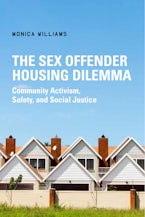The Sex Offender Housing Dilemma
Community Activism, Safety, and Social Justice
The controversy surrounding community responses to housing for sexually violent predators
When a South Carolina couple killed a registered sex offender and his wife after they moved into their neighborhood in 2013, the story exposed an extreme and relatively rare instance of violence against sex offenders. While media accounts would have us believe that vigilantes across the country lie in wait for predators who move into their neighborhoods, responses to sex offenders more often involve collective campaigns that direct outrage toward political and criminal justice systems.
No community wants a sex offender in its midst, but instead of vigilantism, Monica Williams argues, citizens often leverage moral, political, and/or legal authority to keep these offenders out of local neighborhoods. Her book, the culmination of four years of research, 70 in-depth interviews, participant observations, and studies of numerous media sources, reveals the origins and characteristics of community responses to sexually violent predators (SVP) in the U.S. Specifically, The Sex Offender Housing Dilemma examines the placement process for released SVPs in California and the communities’ responses to those placements.
Taking the reader into the center of these related issues, Monica Williams provokes debate on the role of communities in the execution of criminal justice policies, while also addressing the responsibility of government institutions to both groups of citizens. The Sex Offender Housing Dilemma is sure to promote increased civic engagement to help strengthen communities, increase public safety, and ensure government accountability.
Contributor Bios
Reviews
"Monica Williams intervenes in an intense debate over whether litigation or politics is the most effective way to pursue social change and what leads so many social movements to choose courts. By identifying both empowerment and experience as factors that shape these choices, Williams is developing a theoretical approach to rights mobilization that will have plenty of application outside the criminal field...Impressive work" ~ Jonathan Simon,Author of Mass Incarceration on Trial: A Remarkable Court Decision and the Future of Prisons in A
"Readers are invited into community meetings to hear directly from citizens and activists who seek to influence an aspect of public policy that is often ignored: the siting of released sex offenders. Taking nothing for granted, Monica Williams compares three communities in order to show the way social mobilization is shaped by context and orientations to authority. The ethnographic work is truly outstanding and the analysis is keen. The Sex Offender Housing Dilemma is a remarkable account of how communities respond to sex offender placements and should renew scholarly interest in how punishment and democracy play out locally." ~ Chrysanthi S. Leon,Author of Sex Fiends, Perverts, and Pedophiles: Understanding Sex Crime Policy in America
 This work is licensed under a
Creative Commons Attribution-NonCommercial-ShareAlike 4.0 International License
(CC BY-NC-SA).
This work is licensed under a
Creative Commons Attribution-NonCommercial-ShareAlike 4.0 International License
(CC BY-NC-SA).


